Understanding the Impact of Reservoir Low-Permeability Subdomains in the Steam Injection Process
Abstract
1. Introduction
2. Materials and Methods
2.1. Reservoir Modeling
2.2. Fluid and Rock Properties
2.3. Case Study—Low Permeability Barriers
3. Results and Discussion
4. Conclusions
- The presence of subdomain regions of low permeability generally reduces the final percentage of recovered oil.
- The shape and the number of dispersed barriers can anticipate or delay the increase in oil flow. We verified that the production was anticipated for the case with greater dispersion of barriers at smaller sizes.
- The barriers impact the heat front’s advance, generating more heterogeneous heat fronts.
- The presence of geological barriers must be considered when designing a field development project.
- Although we evaluate different barrier configurations, for future works, we suggest more simulations to obtain results, including a higher quantity of subdomains and varying the distribution of the subdomains.
- These studies can aid the development of steam injection projects.
Supplementary Materials
Author Contributions
Funding
Data Availability Statement
Acknowledgments
Conflicts of Interest
References
- Lu, H.; Guo, L.; Zhang, Y. Oil and Gas Companies’ Low-Carbon Emission Transition to Integrated Energy Companies. Sci. Total Environ. 2019, 686, 1202–1209. [Google Scholar] [CrossRef] [PubMed]
- da Silva Martins, S.S.; de Azevedo, M.O.; da Silva, M.P.; da Silva, V.P. Produção de Petróleo e Impactos Ambientais: Algumas Considerações. Holos 2015, 6, 54. [Google Scholar] [CrossRef]
- Liu, Z.; Wang, H.; Blackbourn, G.; Feng, M.A.; Zhengjun, H.E.; Wen, Z.; Wang, Z.; Yang, Z.; Luan, T.; Zhenzhen, W.U. Heavy Oils and Oil Sands: Global Distribution and Resource Assessment. Acta Geol. Sin. 2019, 93, 199–212. [Google Scholar] [CrossRef]
- Araújo, E.A.; Aum, P.T.P.; Fernandes, G.M.D.; Braga, G.S.; Oliveira, G.C.P.; Santos, M.D.; Diniz, A.A.R. A Study on Continuous and Intermittent THAITM Processes in Brazil’s Northeastern Region. Pet. Sci. Technol. 2018, 36. [Google Scholar] [CrossRef]
- Fernandes, G.M.D.; Araújo, E.A.; Aum, P.T.P.; Diniz, A.A.R.; Barillas, J.L.M. Analysis of Different Oil-Well Configurations in the Sagd Process Considering Pressure Drop and Heat Loss in the Injection Well. Braz. J. Pet. Gas 2019, 13, 103–109. [Google Scholar] [CrossRef]
- Castro Dantas, T.N.; de Souza, T.T.C.; Dantas Neto, A.A.; de Alencar Moura, M.C.P.; de Barros Neto, E.L. Experimental Study of Nanofluids Applied in EOR Processes. J. Surfactants Deterg. 2017, 20, 1095–1104. [Google Scholar] [CrossRef]
- Vieira, R.A.M.; Pizarro, J.O.S.; Oliveira, L.A.; Oliveira, D.F.B.; Passarelli, F.M.; Pedroni, L.G. Offshore EOR Initiatives and Applications in Brazil: An Operator Perspective. In Proceedings of the Offshore Technology Conference, Houston, TX, USA, 4–7 May 2020. [Google Scholar] [CrossRef]
- Xu, Z.X.; Li, S.Y.; Li, B.F.; Chen, D.Q.; Liu, Z.Y.; Li, Z.M. A Review of Development Methods and EOR Technologies for Carbonate Reservoirs. Pet. Sci. 2020, 17, 990–1013. [Google Scholar] [CrossRef]
- Gao, Y.; Wang, X.; Jiang, H.; Ding, S. Numerically Coupled Thermo-Hydro-Mechanical Analyses of Ultra-Heavy Oil Reservoirs during the Micro-Fracturing Stage. Energies 2022, 15, 3677. [Google Scholar] [CrossRef]
- Wang, C.; Wu, Y.; Luo, C.; Jiang, Y.; Zhang, Y.; Zheng, H.; Wang, Q.; Zhang, J. Experimental Study and Numerical Simulation of an Electrical Preheating for SAGD Wells in Heavy Oil Reservoirs. Energies 2022, 15, 6102. [Google Scholar] [CrossRef]
- Al-Atwah, I.; Alshaikh, M.; Sweet, S.T.; Knap, A.; Hascakir, B. Extension of Existing Screening Criteria Tables for Thermal Enhanced Oil Recovery Methods Through Compositional Analyses of Heavy Oils. In Proceedings of the SPE Western Regional Meeting, Garden Grove, CA, USA, 22–26 April 2018. [Google Scholar]
- Chen, X.; Rao, X.; Xu, Y.; Liu, Y. An Effective Numerical Simulation Method for Steam Injection Assisted In Situ Recovery of Oil Shale. Energies 2022, 15, 776. [Google Scholar] [CrossRef]
- Medina, O.E.; Hurtado, Y.; Caro-Velez, C.; Cortés, F.B.; Riazi, M.; Lopera, S.H.; Franco, C.A. Improvement of Steam Injection Processes Through Nanotechnology: An Approach through in Situ Upgrading and Foam Injection. Energies 2019, 12, 4633. [Google Scholar] [CrossRef]
- Ni, J.; Zhou, X.; Yuan, Q.; Lu, X.; Zeng, F.; Wu, K. Numerical Simulation Study on Steam-Assisted Gravity Drainage Performance in a Heavy Oil Reservoir with a Bottom Water Zone. Energies 2017, 10, 1999. [Google Scholar] [CrossRef]
- Mezzomo, R.F.; Dutra, T.V.; de Miranda-Filho, D.N.; de Paula, A.L.; Cursino, D.F.S. Heavy Oil Recovery in Potiguar Basin, Brazil: Steam Flooding from Field Pilot Testing to Commercial Application. In Proceedings of the SPE Rocky Mountain Petroleum Technology Conference, Keystone, CO, USA, 21–23 May 2001. [Google Scholar]
- Araújo, E.A.; Batista, L.C.; Bechara, J.V.O.; Gurgel, A.R.; Oliveira, G.P.; Aum, P.T.P. Influence of High Permeability Subdomains on Steam Injection Performance in Heavy-Oil Reservoirs. J. Pet. Sci. Eng. 2022, 208, 109388. [Google Scholar] [CrossRef]
- Ashrafi, M.; Souraki, Y.; Tor Joergen, V.; Karimaie, H.; Torsaeter, O. Experimental and Numerical Investigation of Steam Flooding in Heterogeneous Porous Media Containing Heavy Oil. In Proceedings of the SPE Asia Pacific Oil and Gas Conference and Exhibition, Jakarta, Indonesia, 20–22 September 2011. [Google Scholar]
- Kalia, N.; Balakotaiah, V. Effect of Medium Heterogeneities on Reactive Dissolution of Carbonates. Chem. Eng. Sci. 2009, 64, 376–390. [Google Scholar] [CrossRef]
- Muljadi, B.P.; Blunt, M.J.; Raeini, A.Q.; Bijeljic, B. The Impact of Porous Media Heterogeneity on Non-Darcy Flow Behaviour from Pore-Scale Simulation. Adv. Water Resour. 2016, 95, 329–340. [Google Scholar] [CrossRef]
- He, Z.; Parikh, H.; Datta-Gupta, A.; Perez, J.; Pham, T. Identifying Reservoir Compartmentalization and Flow Barriers Using Primary Production: A Streamline Approach. In Proceedings of the SPE Annual Technical Conference and Exhibition, San Antonio, TX, USA, 29 September–2 October 2002. [Google Scholar]
- Jaber, A.K.; Al-Jawad, S.N.; Alhuraishawy, A.K. A Review of Proxy Modeling Applications in Numerical Reservoir Simulation. Arab. J. Geosci. 2019, 12, 701. [Google Scholar] [CrossRef]
- Yang, S.; Nie, Z.; Wu, S.; Li, Z.; Wang, B.; Wu, W.; Chen, Z. A Critical Review of Reservoir Simulation Applications in Key Thermal Recovery Processes: Lessons, Opportunities, and Challenges. Energy Fuels 2021, 35, 7387–7405. [Google Scholar] [CrossRef]
- Barillas, J.L.M.; Dutra, T.V.; Mata, W. Reservoir and Operational Parameters Influence in SAGD Process. J. Pet. Sci. Eng. 2006, 54, 34–42. [Google Scholar] [CrossRef]
- le Ravalec, M.; Morlot, C.; Marmier, R.; Foulon, D. Impact Des Hétérogénéités Sur La Production d’huiles Lourdes Mobiles Par SAGD. Oil Gas Sci. Technol. 2009, 64, 469–476. [Google Scholar] [CrossRef]
- Xu, J.; Chen, Z.; Dong, X.; Zhou, W. Effects of Lean Zones on Steam-Assisted Gravity Drainage Performance. Energies 2017, 10, 471. [Google Scholar] [CrossRef]
- Wu, Y.; Li, X.; Jiang, Y.; Wang, H.; He, W. Reservoir Simulation of Shale Barrier Failure in Heterogeneous SAGD Reservoirs: A Case Study; SPE 165941. In Proceedings of the SPE Reservoir Characterization and Simulation Conference and Exhibition, Abu Dhabi, United Arab Emirates, 16–18 September 2013. [Google Scholar]
- Hoyos Perdomo, R.; Ardila Cubillos, L.; Munoz Navarro, S.; Rincon Canas, M.; Palma-Bustamante, J.; Naranjo Suarez, C. Evaluation of Different Strategies for Selective Steam Injection in Stratified Heavy-Oil Reservoirs. SPE-171143-MS. In Proceedings of the SPE Heavy and Extra Heavy Oil Conference: Latin America, Medellín, Colombia, 24–26 September 2014. [Google Scholar]
- Zhong, L.; Han, X.; Yuan, X.; Liu, Y.; Zou, J.; Wang, Q. Permeability Variation and Its Impact on Oil Recovery from Unconsolidated Sand Heavy-Oil Reservoirs during Steamflooding Process. SPE Reserv. Eval. Eng. 2021, 24, 159–173. [Google Scholar] [CrossRef]
- Batarseh, S.; Assiri, W.; SanRoman Alerigi, D.; Khaldi, B. Formation Heterogeneity Effect on Steam Injection and Propagation. In Proceedings of the Abu Dhabi International Petroleum Exhibition & Conference, Abu Dhabi, United Arab Emirates, 15–18 November 2021. [Google Scholar]

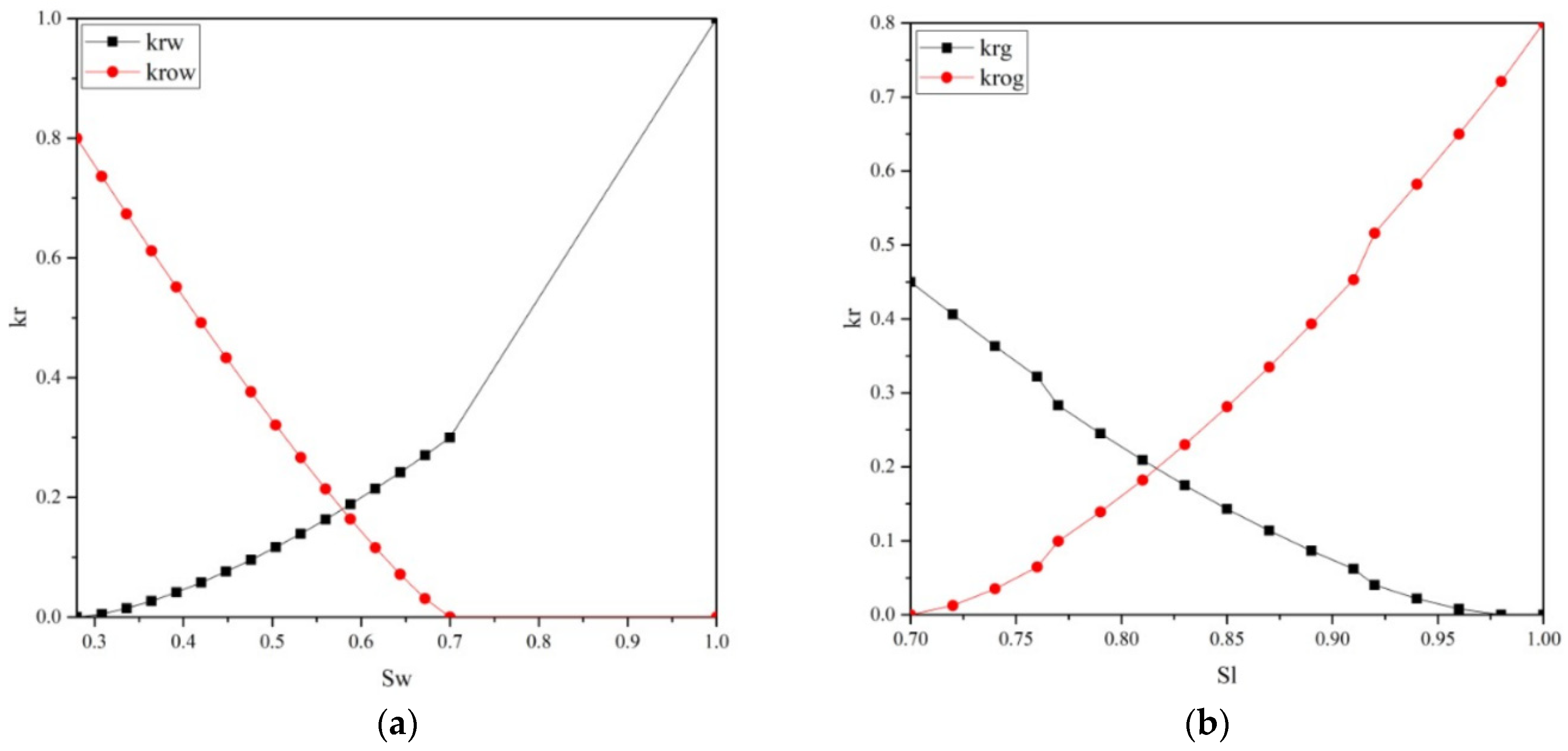
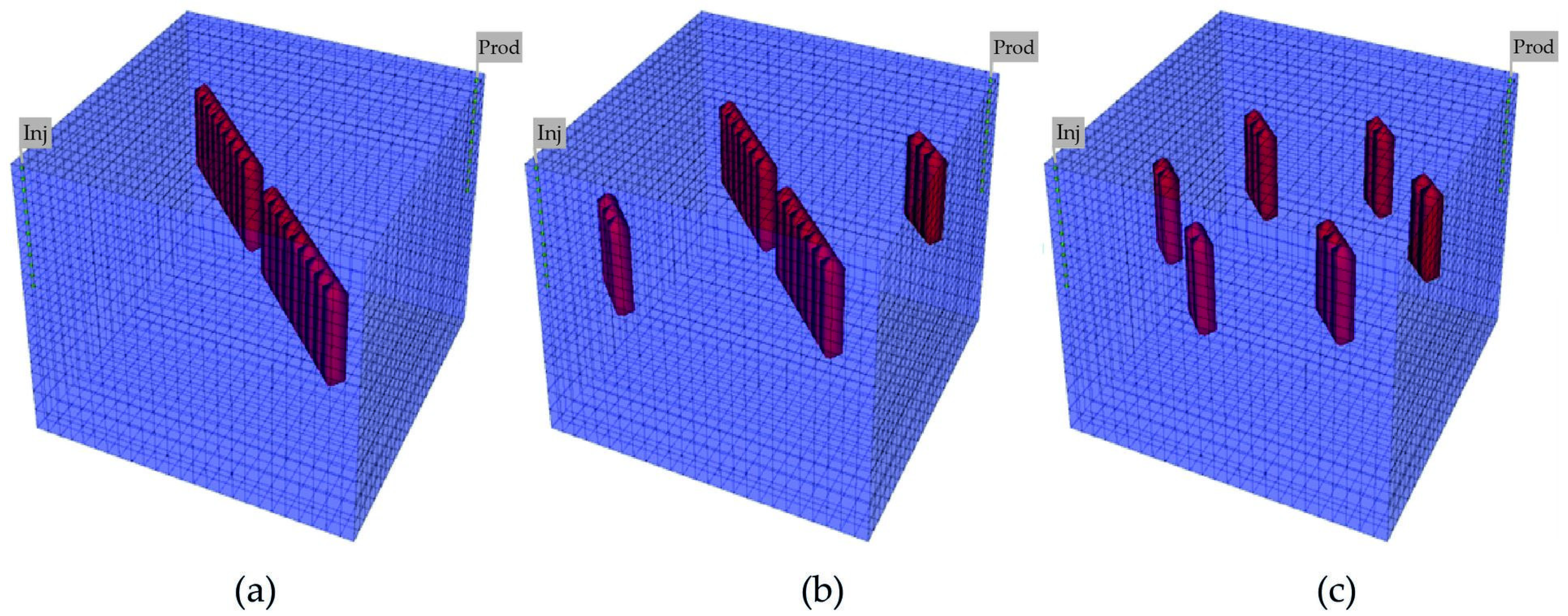
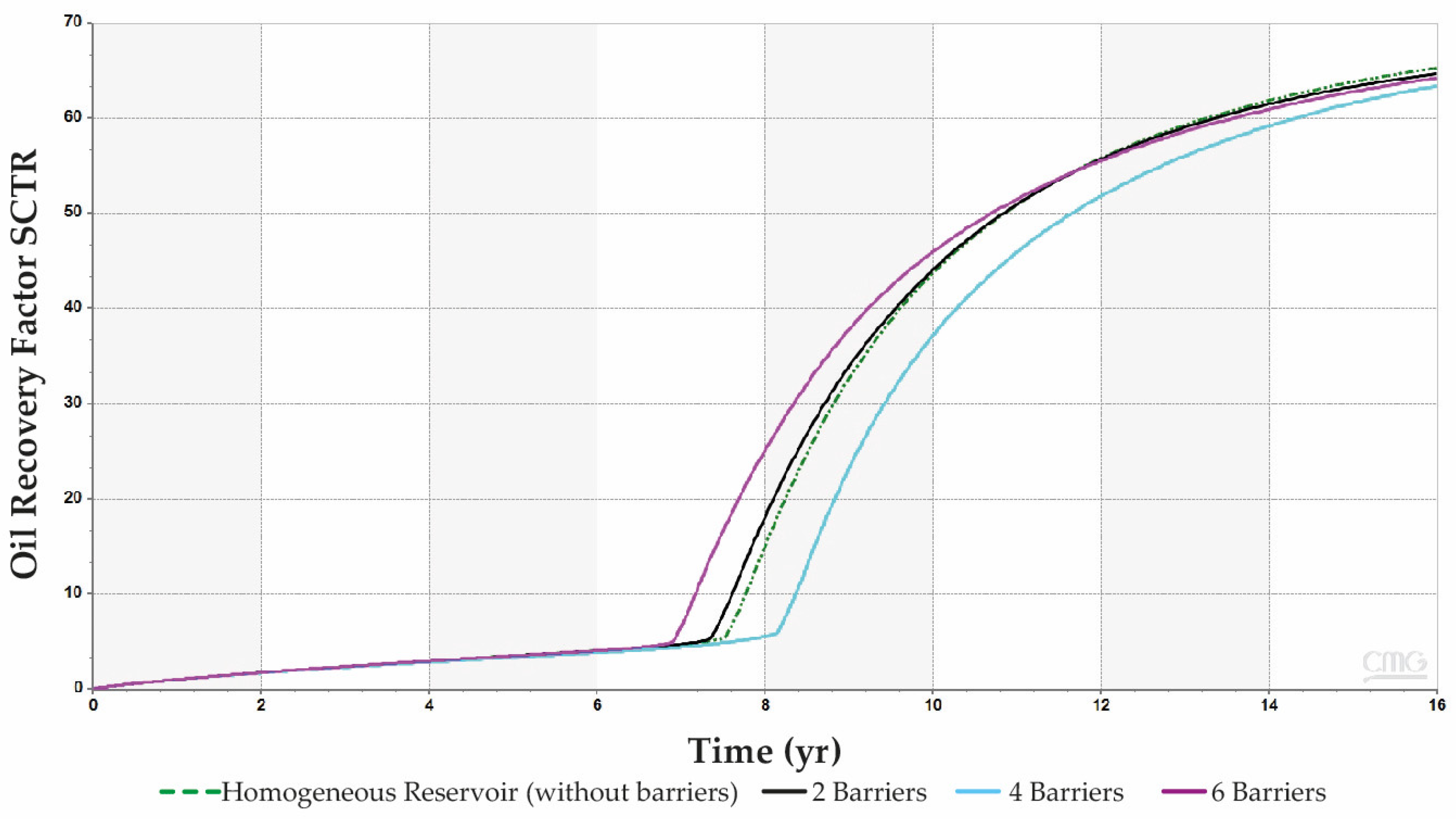


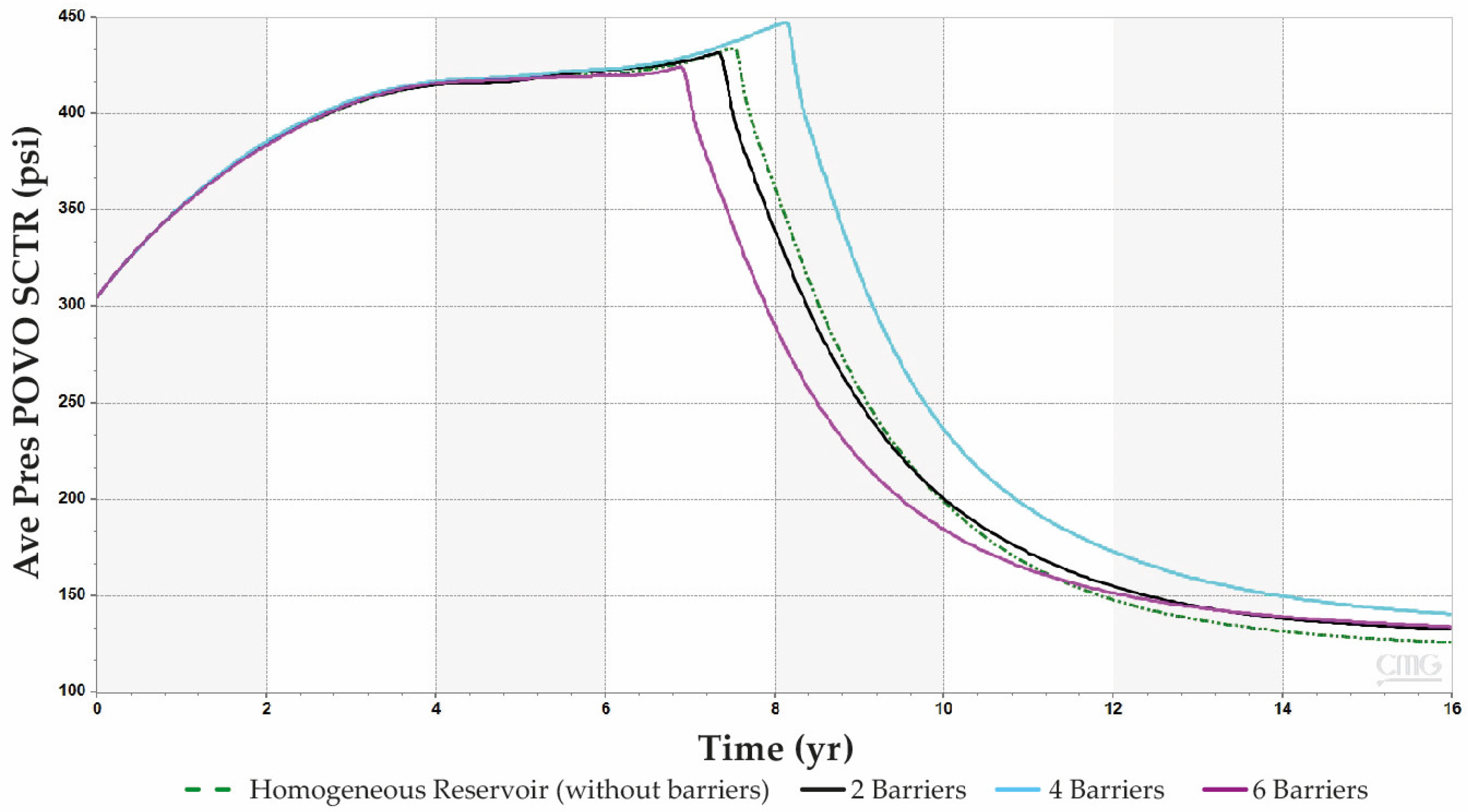
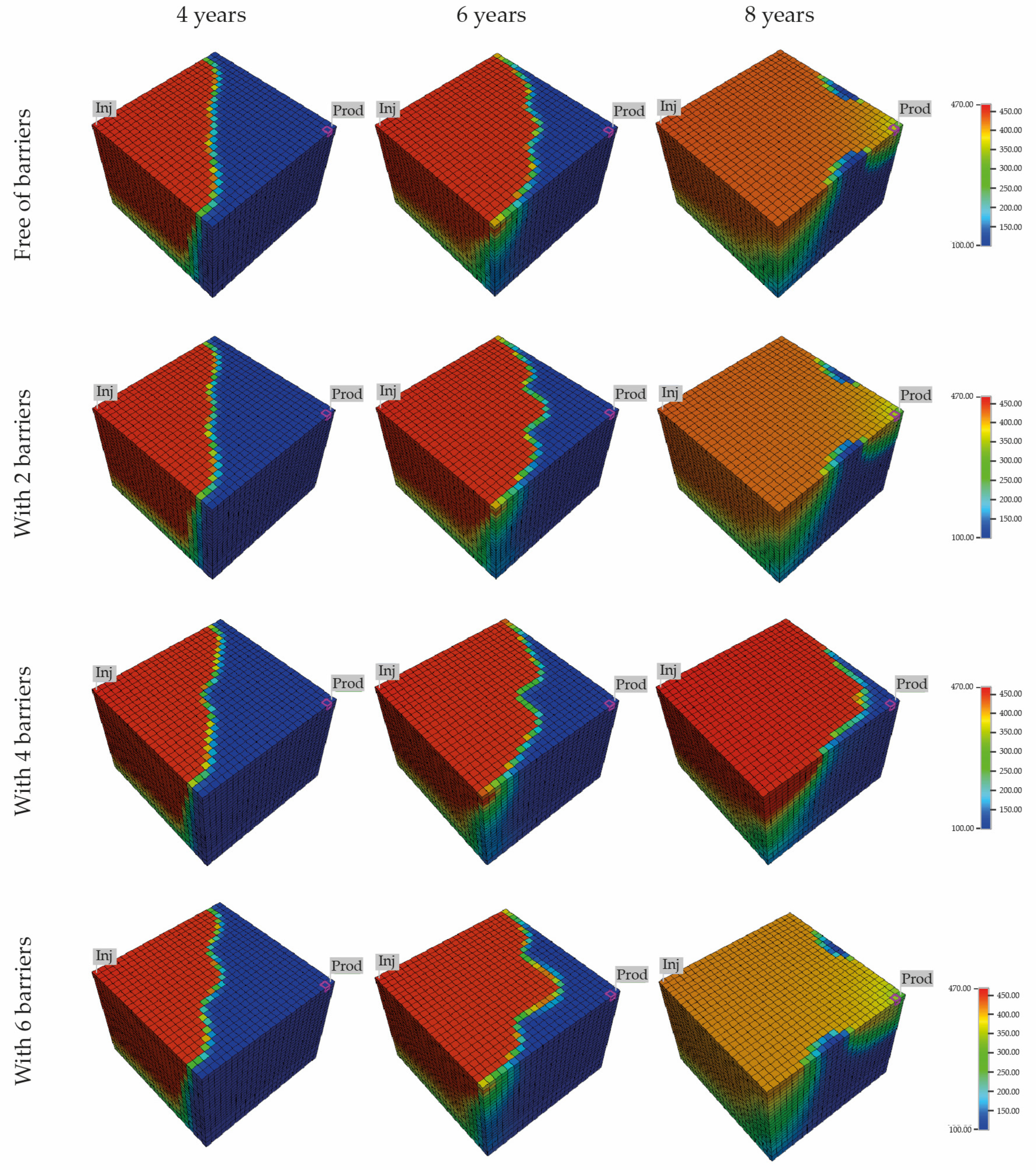

| Properties | Values (Base Model) |
|---|---|
| Maximum pressure in the injector well (kPa) | 7196.14 |
| Minimum pressure in the producer well (kPa) | 196.45 |
| Pressure at the top of the reservoir (KPa) | 1978 |
| Steam quality (%) | 75 |
| Porosity (%) | 30 |
| Horizontal permeability (mD) | 1000 |
| Vertical permeability (mD) | 100 |
| Initial temperature of the reservoir (°C) | 38 |
| Rock thermal conduction (J/(s m °C)) | 1.73 |
| Connate water saturation | 0.36 |
| Total blocks | 14,375 |
| Pseudocomponents/Components | Molar Fraction (%) |
|---|---|
| CO2 | 0.40 |
| N2 | 0.15 |
| C1–3 | 8.03 |
| C4–5 | 0.33 |
| C6–9 | 0.27 |
| C10–19 | 17.25 |
| C20–39 | 47.44 |
| C40+ | 26.13 |
| Pressure (kPa) | Bo | Rs | ||
|---|---|---|---|---|
| 6965.63 | 1.0270 | 935.5 | 34.81 | 819.20 |
| 5884.99 | 1.0280 | 935.0 | 34.81 | 794.40 |
| 5004.35 | 1.0290 | 934.5 | 34.81 | 769.20 |
| 4023.64 | 1.0295 | 934.0 | 34.81 | 741.60 |
| 2650.75 | 1.0300 | 933.5 | 34.81 | 706.20 |
| 1572.00 | 1.0250 | 936.0 | 21.33 | 816.30 |
| 101.03 | 1.0150 | 942.0 | 00.00 | 1121.1 |
Disclaimer/Publisher’s Note: The statements, opinions and data contained in all publications are solely those of the individual author(s) and contributor(s) and not of MDPI and/or the editor(s). MDPI and/or the editor(s) disclaim responsibility for any injury to people or property resulting from any ideas, methods, instructions or products referred to in the content. |
© 2023 by the authors. Licensee MDPI, Basel, Switzerland. This article is an open access article distributed under the terms and conditions of the Creative Commons Attribution (CC BY) license (https://creativecommons.org/licenses/by/4.0/).
Share and Cite
Santana, B.d.S.; Batista, L.C.; Araújo, E.d.A.; Lucas, C.R.d.S.; da Silva, D.N.N.; Aum, P.T.P. Understanding the Impact of Reservoir Low-Permeability Subdomains in the Steam Injection Process. Energies 2023, 16, 639. https://doi.org/10.3390/en16020639
Santana BdS, Batista LC, Araújo EdA, Lucas CRdS, da Silva DNN, Aum PTP. Understanding the Impact of Reservoir Low-Permeability Subdomains in the Steam Injection Process. Energies. 2023; 16(2):639. https://doi.org/10.3390/en16020639
Chicago/Turabian StyleSantana, Beatriz dos Santos, Lorena Cardoso Batista, Edson de Andrade Araújo, Cláudio Regis dos Santos Lucas, Daniel Nobre Nunes da Silva, and Pedro Tupã Pandava Aum. 2023. "Understanding the Impact of Reservoir Low-Permeability Subdomains in the Steam Injection Process" Energies 16, no. 2: 639. https://doi.org/10.3390/en16020639
APA StyleSantana, B. d. S., Batista, L. C., Araújo, E. d. A., Lucas, C. R. d. S., da Silva, D. N. N., & Aum, P. T. P. (2023). Understanding the Impact of Reservoir Low-Permeability Subdomains in the Steam Injection Process. Energies, 16(2), 639. https://doi.org/10.3390/en16020639









